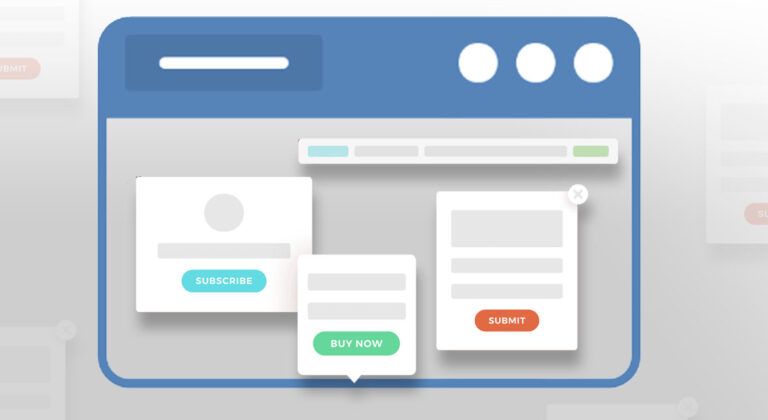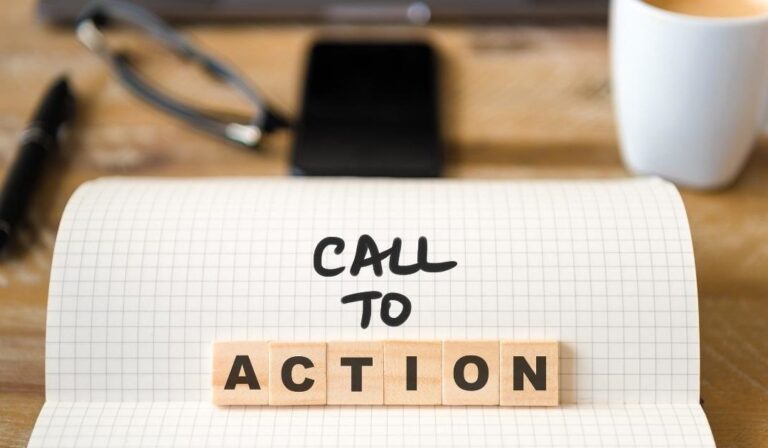36 Foolproof Headline Writing Tips You Should Know

I hope you enjoy this blog post. If you want Hello Bar to grow your leads, click here.
Author:
Ryan Bettencourt
Published
June 13, 2024
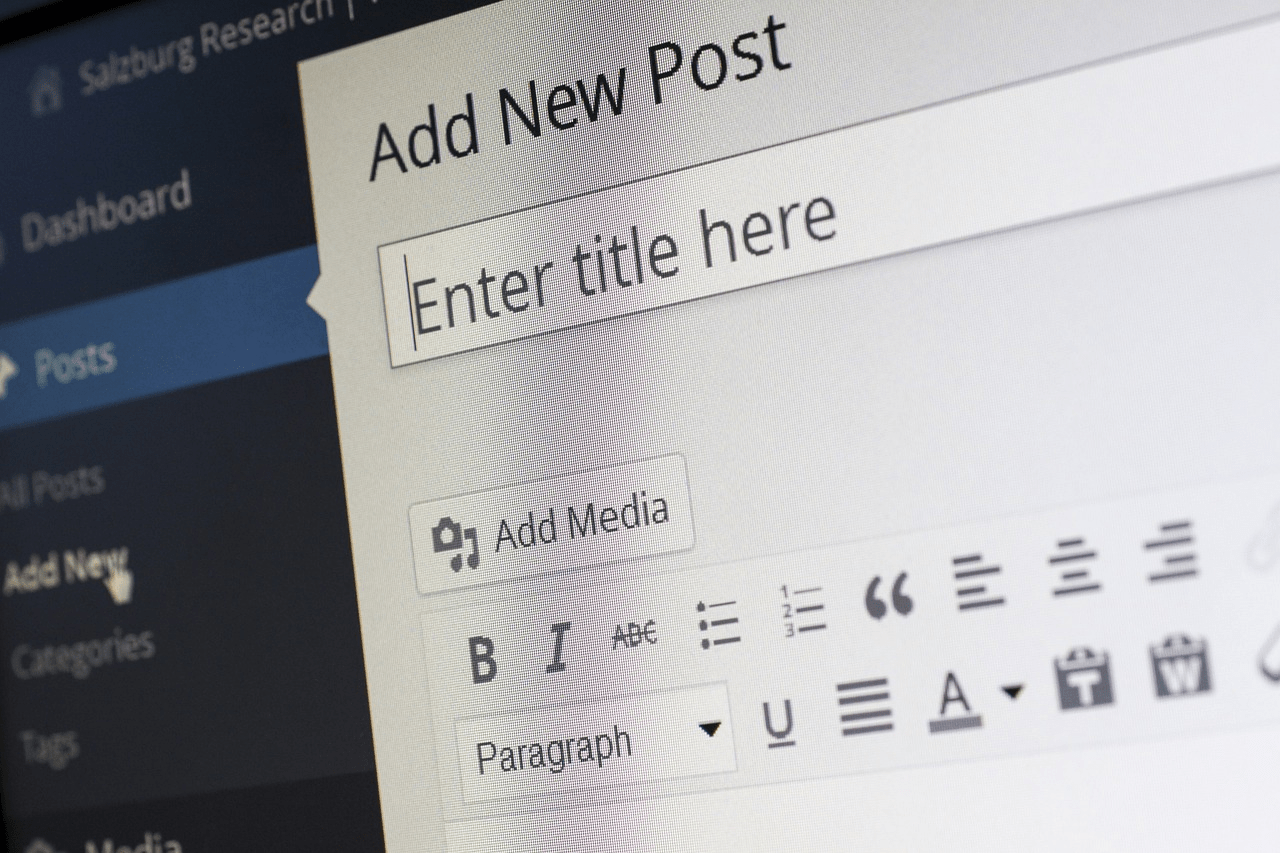
Be it a story, an advertisement, an article, or a video, they all are incomplete without a headline. It serves as the first point of contact with the audience, aiming to grab attention while summarizing the following content.
These days, headlines serve a greater purpose than just being the introductory line. They are a crucial element of any marketing strategy. This holds true whether you’re launching a blog, a podcast, or an email campaign.
In this article, we’ll explore practical headline writing tips and best practices. We also delve into success metrics and popular formulas to help you craft compelling headlines.
Let’s get started.
What is a Headline?

A headline serves as the title or initial text of content, offering an extremely specific and concise summary. It is an integral part of a newspaper article, blog post, ad, social media post, video, or even an email.
A headline serves essential functions in several contexts:
- Advertising: Highlights key selling points or benefits of a product/service.
- Social Media: Sparks curiosity and encourages further exploration.
- Blog Post or Video Title: Summarizes the video’s content and captivates viewers’ interest.
- Email Subject Line: Concisely captures the essence of the email, prompting opens and engagement.
Essentially, a headline is a gateway to your content. It appears in search results, links, social shares, and beyond.
How to Maximize Results With Catchy Headlines

If you struggle to apply techniques for writing great headlines, you’re not alone. Many times, the right headline doesn’t come to me right away.
However, we also use tools to help grab the readers’ attention. Hello Bar, for instance, allows you to maximize the visual impact of a given headline.
Exit popups and regular Hello Bars both help drive more traffic through your website. Convince people to visit other pages and therefore remain on your site for longer periods of time.
For instance, you can make your Hello Bar whatever size you wish. Sometimes, bigger really is better because it grabs your readers’ attention.
Consider A/B testing different sizes, and let Hello Bar calculate the results of the test for you.
It’s important to consider several factors before you even start to write a headline, which means it might take some effort. Following are a few headline writing tips to consider.
Study your audience
The more you know about your audience, the more effective your headlines become. Do they like listicles (articles based on a list of items, tips, strategies, etc.)? Q&As? Tutorials?
Review the web traffic to all blog posts you’ve written in the last six months. Look for patterns. You might find, for instance, that you get the most clicks when your headline is front-loaded with a number or statistic.
Share personal benefits
Headlines perform best when they convey a personal benefit to the reader. In other words, what can the reader take away from the rest of the content?
This is why listicles work so well:
- 11 Ways to Shed Weight Quickly
- 15 Steps to Become a Better Runner
- 7 New Strategies for Healthy Cooking
In each of these examples, the benefit and the takeaway are present in the title.
Follow the 4 U’s
Acronyms might seem cheesy, but they work — not least of all because they’re easy to remember.
The 4 U’s of writing effective headlines are pretty simple:
Unique
Make sure nobody else has used a headline like yours. Not only will you struggle to compete in the SERPs, but if someone has already read your competition’s article, they probably won’t click on yours.
It’s easy to craft a unique headline if you know the content that already exists. Run Google searches for permutations of your primary keyword. When you write your own headline, make sure it doesn’t look similar to those in the search engine results pages.
Consider using unique words, too. They shouldn’t be too obscure — you want to get your message across — but consider using a word that wouldn’t normally be paired with the content you’ve created.
Ultra-specific
One of the best headline writing tips for writing headlines is to drill down on your topic as tightly as possible. It’s kind of like narrowing your niche. You want to let the reader know exactly what he or she will get.
Consider these two headlines:
- How to Run a Marathon
- 77 Steps to Running Your First Marathon in High Humidity
The second one is far more specific, right? It tells the reader what will be delivered and narrows down the subject matter to show that it isn’t going to contain fluff and filler.
Don’t be afraid of using extra words. If you keep your headline to about 77 characters or fewer, you’ll do fine.
Useful
This sounds obvious, but if you scan many of the headlines on some of today’s blogs, you’ll see that it isn’t. Many creatives get a little too creative with their headlines — and confuse their readers in the process.
Furthermore, every piece of content you write should have a specific purpose. It needs to tell a story, provide value, and allow your reader to accomplish something, whether it’s reaching a goal or solving a problem.
Urgent
Urgency is a marketer’s best friend. If you can convince your reader that he or she needs to act now, you’ll have done your job well.
Time-bound headlines can work well, but only for a short period of time. For instance, Black Friday articles often pop up in droves in the weeks leading up to Thanksgiving. Articles like these enjoy only seasonal popularity.
However, you can incorporate urgency into the article’s goal. Check out a few examples:
- How to Prep for Your First Marathon in 6 Weeks
- Why You Should Start Training for Your Marathon Today
- 17 Runners’ Tips You’ve Been Missing Out On
These headlines entice clicks because the reader wants to know what he or she is missing.
36 Effective Headlines Writing Tips and Techniques That Are Proven to Work

Now that we’ve covered some of the basic headline writing tips, let’s dive into the good stuff. Learning new techniques for writing headlines can help you become a better writer all around.
For instance, you can use these same strategies on your subheadings and even in your body copy. They can help keep your readers moving through the piece until the very end, which improves metrics like time on page.
Following are 36 effective headline writing tips and techniques for writing unique and attractive headlines.
1. Use Strong Words in Your Headlines
Believe it or not, words can be classified as strong or weak. The difference depends on the impact the word has on the reader.
Study the headlines of the articles you enjoy most. What words did the author include in the headline? And in what order?
You’ll start to pick out patterns in the best headlines. They use strong verbs that convey action, motion, and achievement. They also eliminate stop words (words like of, for, nor, a, the, etc.) unless they’re necessary for the headline to make sense.
CoSchedule’s blog post title demonstrates the effectiveness of this strategy. Notice how adding “That Will Get You Inspired” makes it more compelling.

Image via CoSchedule
This headline reassures readers that there’s light at the end of the tunnel.
2. Make Creative and Bold Statements When Writing Headlines
There’s no reason to put your creativity on a leash when you’re writing headlines. In fact, one of the best headline writing tips is to let your creativity flourish.
Feel free to make a bold or controversial statement. Maybe your opinion differs from the other movers and shakers in your industry. Don’t be afraid to take a stand.
You can also use the negative approach to garner clicks. For instance, I could have changed this title to the following: Why You’re Not Writing Good Headlines.” In other words, tell your readers what they’re doing wrong — and how to fix it.
The HOTH, a digital marketing company, loves to use this trick in their blog posts. Check out the example below:

Image via The HOTH
It piques your curiosity, right? That’s because it challenges the norm, making you eager to see their perspective.
3. Ask a Funny or Uncommon Question
“How Many Headlines Can You Write in an Hour?”
That’s a great headline for an article on this kind of topic. It gets the creative juices flowing not just for the reader, but also for the writer.
“Why Do Your Headlines Suck So Much?”
That’s another one that incorporates a dollop of humor. Just make sure you don’t offend your audience if you employ sarcasm or wit as part of your headline.
4. Use Interesting Adjectives That People Will Remember
Our next choice in this list of headline writing tips is too simple to believe. Adjectives are meant to clarify the noun in a headline or sentence. They can also add color and interest.
Let’s look at one of our headline examples from above: “17 Runners’ Tips You’ve Been Missing Out On”
How can we spiff this up and make it more compelling for readers.
I might change it to this: “17 No-Nonsense Runners’ Tips You’ve Been Missing Out On”
It suggests that the article will be filled with valuable, actionable material. I could trade out that adjective for many others:
- 17 Fascinating Runners’ Tips You’ve Been Missing Out On
- 17 Foolproof Runners’ Tips You’ve Been Missing Out On
- 17 Actionable Runners’ Tips You’ve Been Missing Out On
Each of these adjectives help clarify the noun “tips” for the reader.
5. Use Superlatives When Suitable
Superlatives (words indicating the best, highest, greatest, etc.) can make or break your headline. If you use them when they’re not applicable, you’ll generate more eye rolls than clicks. However, if you can back up your statement, go forth and use superlatives.
- 17 Best Runners’ Tips You’ve Been Missing Out On
- 17 Most Effective Runners’ Tips You’ve Been Missing Out On
- 17 Hottest Runners’ Tips You’ve Been Missing Out On
YouTuber Joshua Weissman loves to grab attention with bold headlines.
For example, check out his video titled “The Easiest Chocolate Cake of All Time.” This clever title speaks to home bakers’ struggles and is sure to boost views.
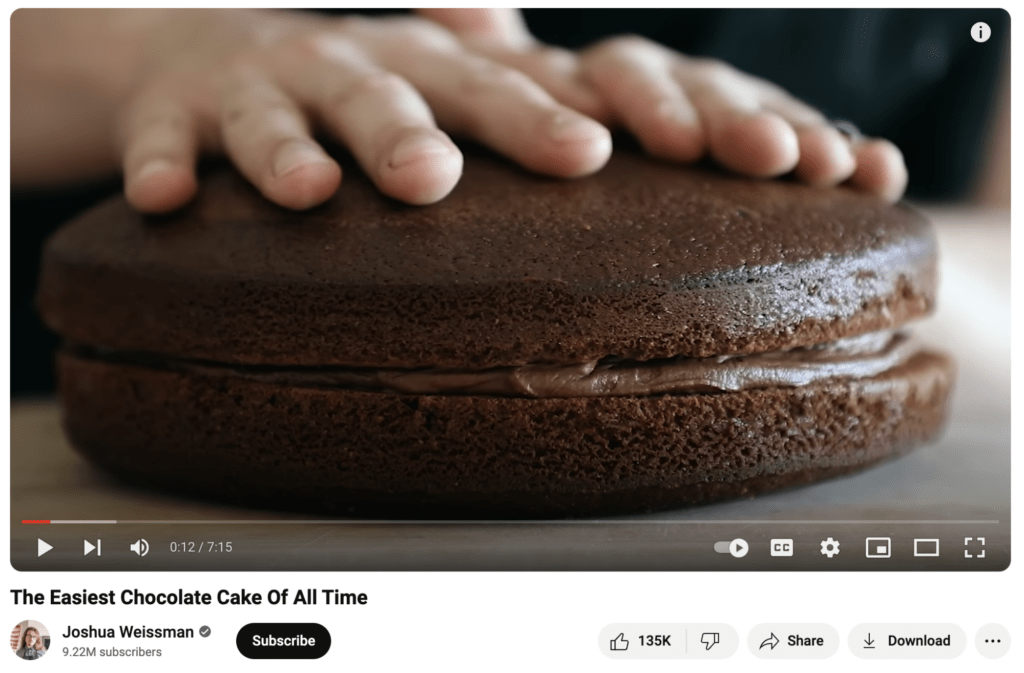
Image via YouTube
6. Be Concise To Write a Powerful Headline
Writers — especially newbies — sometimes produce verbose copy. That’s fine, but when you’ve finished your first draft, go through and pare down the verbiage.
Let’s look at two examples of passages I might write for our fictional article about marathon running:
- In order to stay in shape, you need to run a minimum of at least three days out of the week. On another two days, focus on keeping your body limber through stretching.
- To stay in shape, run a minimum of three days per week. On two days, focus on stretching instead to stay limber.
In these examples, we have a wordy passage (number one) and a more concise one (number two). I edited 33 words down to 22.
How? For the most part, I removed unnecessary phrases. “In order to” becomes merely “To.” I didn’t need to say “a minimum of” and “at least” because they say the same thing. I removed unnecessary words and rephrased to make the second sentence clearer.
This is never more true than when you’re crafting your headline. An overlong or wordy headline will either confuse or irritate your readers. They might not even understand what you’re trying to communicate.
7. Create Urgency When You Write Headlines
Urgency is our next pick in this list of helpful headline writing tips. It’s like a magic wand you wave in front of your audience. When executed correctly, urgency leaves readers with no choice but to click.
Such clickbait headlines can come in many forms, such as the following:
- You Can Start a New Business in 2 Weeks or Less. Here’s How.
- Learn the Fastest Way to Shed Baby Weight Safely
- I’m Sharing My Best [Topic] Secrets. Limited Time Only.
It works best for an article that can help your reader accomplish something faster. You’re offering shortcuts, workarounds, or better strategies.
In the last example, I’m teasing a revelation. People who don’t click right now won’t get to learn my secrets.
Here’s another gem from a YouTuber sharing valuable tips on running online businesses. The headline promises quick money-making tips. Who wouldn’t want that, right?

Image via YouTube
8. Incite Readers’ Curiosity With Your Headline
BuzzFeed does this really well. The publication has recently featured headlines like these:
- Choose Your Favorite Breakfast Foods And We’ll Reveal If You’re A Jedi Or A Sith
- This Person Got Totally Duped By The Online Photos Of A Hotel They Booked And People Can’t Stop Laughing
- Can You Figure Out The Deep Meaning Behind This Comic About Social Media?
The headlines work because they inspire curiosity. The content itself might not be life-changing, but the headline gets the click.
You can do the same with more serious pieces by asking an evocative question:
- What Type of Runner Are You?
- Which of These Marathon Training Mistakes Are You Making?
- We Trained for a Marathon in 3 Weeks. Here’s What Happened.
9. Create Humor Playing With Some Words
Did you ever watch the HBO television series “True Blood”? When vampire Bill Compton tells Sookie the name of the vampire bar in Shreveport — Fangtasia — she does an eye roll.
Compton replies, “You have to remember that most vampires are very old. Puns used to be the highest form of humor.”
Far be it for me to disagree with a fictional vampire, but puns are still funny. And they still work in headlines.
If you can write headlines that incorporate a play on words, you’ll incite immediate curiosity.
10. Include a Hyphen or a Colon in Your Blog Post Headline
Yes, punctuation matters! It sounds silly, but it can drive reader interest. It might also help with SEO.
You’ll notice that the headline for this article uses a colon. You could also replace it with a hyphen or em-dash to get the same effect.
Let’s look at three headlines:
- Training For Your First Marathon: The Complete Guide
- Training For Your First Marathon — The Complete Guide
- The Complete Guide to Training For Your First Marathon
There’s nothing inherently wrong with the last headline. However, it won’t grab the reader as quickly.
We focus on the first part of a headline. So do search engines like Google. If you can get the primary keyword at the beginning of the headline, you have a better chance for clicks and better rankings.
Essentially, hyphens and colons allow you to break up your headline into two parts. You can communicate more information that way and arrange your headline for both reader interest and SEO.
11. Use Rationale — A Strong Reason To Click
A rationale is simply an inducement to click. It gives the reader an excuse to see what the article has to offer.
You find rationale words in many listicles and tutorials. Some of the most common include the following:
- Tips: 17 Tips for Better Marathon Performance
- Strategies: 17 Strategies to Improve Your Marathon Time
- Lessons: 17 Lessons You Can Learn From Famous Runners
- Ways: 17 Ways to Improve Your Running Times
- Types: 17 Types of Running Exercises to Try
- Times: 17 Times Famous Runners Have Surprised Us
12. Make Your Headline Simple and Easy To Understand
While puns and adjectives can make headlines more clickable, you don’t want to go overboard. When in doubt, go by one of the best headline writing tips: keep it short, sweet, and simple.
In other words, communicate a benefit to the reader and the reason you’re writing the article. That’s it. If it takes 10 words, that’s fine. If it only takes four words, that’s fine, too.
Take a look at the headline in HelpGuide.org’s blog post. It’s incredibly straightforward yet effectively conveys the article’s topic.
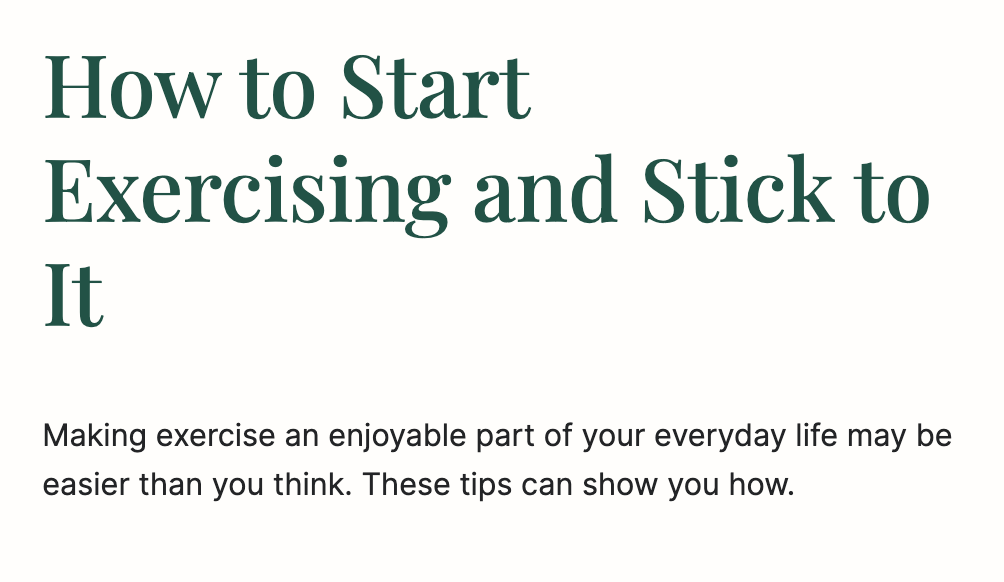
Image via HelpGuide.org
This clarity not only reduces confusion but also amps up engagement.
13. Address the Reader As “You”
You’ve heard of personalized marketing, right? It’s a way to make every communication with your followers feel like it’s meant just for them.
You might include your subscribers’ first names in your mass emails to them, for example. Your email sounds less like a marketing message and more like a missive from a friend.
For instance, if you’re educating people about marathon running, a catchy email subject line could look like one of these:
- How to Train For Your Next Marathon
- Are You Ready to Start Training For That Marathon?
The second one is more inviting, right? It’s more casual, and it sounds like it’s written just for the recipient.
However, you don’t need first names to personalize a headline. Just use the word “you.” Even though it’s meant for public consumption, it sends the subtle message that it’s for that particular reader alone.
This approach is evergreen and shines in various contexts. Take a look at this example from HuffPost’s personal essays section.

Image via HuffPost
Don’t you think the headline does an exceptional job of directly addressing the reader?
14. Include Specific Numbers and Data in Your Headline
Numbers are kind of like magic for headlines. They automatically attract attention.
My business partner, Neil Patel, recently published an article about how much he’s spending on YouTube ads:

That’s a big number, right? It catches your attention right away.
Statistics can serve the same purpose. For instance, if you have the data, you could write an article with one of these headlines:
- Why 68 percent of runners hate [brand name] shoes
- Did you know that 89 percent of runners use this stretch before every run?
- Study finds that only 20 percent of runners have knee problems
15. Telegraph Emotions With Your Headlines
Making your readers feel a deep emotion in just a few words is tough, but it can be done. It’s much easier if you’re writing about an emotive topic.
For instance, let’s say you want to write about runners’ safety out on the road. You could write an article about wearing safety gear, using reflective badges, and other tips.
Your headline can seal the deal: “Runners, You Don’t Have to Get Run Over. Read On to Protect Yourself.”
It sparks emotion. Nobody wants to get run over during a run. They also want to protect their friends and family members who run.
16. Keep in Mind the Title Length Limits for Different Platforms
Don’t forget about title length limits on different platforms!
Each platform has its own rules. Make sure your titles fit within the specified character counts.
But note that there’s a difference between character limits and optimal limits.
For example, YouTube caps titles at 100 characters. That said, anything over 70 gets snipped with those pesky ellipses.
Email subject lines should ideally stay under 50 characters. Similarly, Google search result titles fare best between 55-60 characters.
Sticking within these boundaries ensures your titles pop with visibility and engage your audience. Use a title generation tool for social media to make sure you don’t exceed character limits.
17. Use AI Tools to Generate Headline Ideas
Our headline writing tips are not just about how to write them but also about finding the right assistance. We understand the ongoing discussions about AI tools, especially in content creation.
Yet, when wielded with finesse, they can truly streamline your headline-generation process.
AI-powered headline generator tools can assist you:
- Delve into current trends to craft timely and relevant headlines.
- AI offers multiple headline options. This allows you to choose the most suitable one for your content.
- Optimize your headlines for search engines with AI-generated suggestions.
And guess what? There’s a treasure trove of AI tools worth using.
For example, Ahrefs provides a free AI title generator for blog articles. Similarly, MonsterInsights offers a tool for headline analysis:
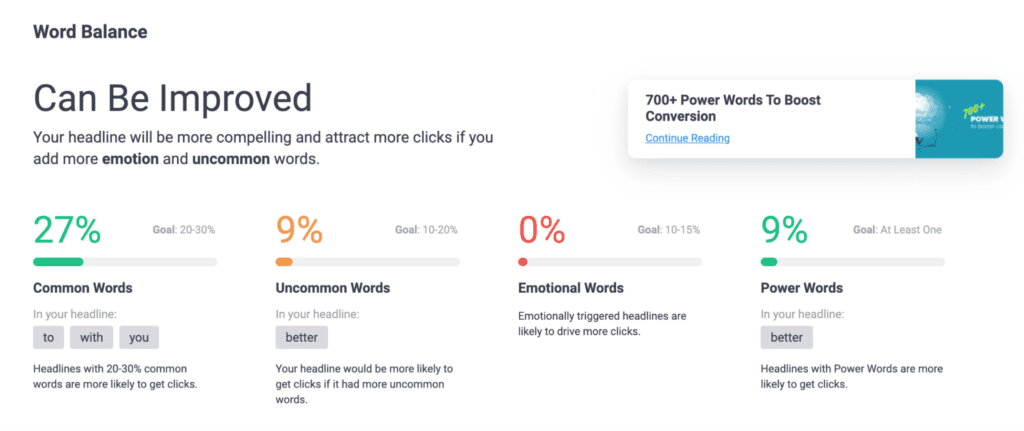
Image via MonsterInsights
18. Test Your Headlines
One of the obvious yet easily ignored headline writing tips is effective testing. You could speculate as to what headlines will perform best. You could conduct competitor analyses, use AI tools, and maximize your creativity.
However, the only true test of gauging efficacy is by testing it. Here are some ways to do this:
- A/B Testing: Pit two different headline variations against each other. This will help you gauge which one performs better.
- Social Media Polls: Engage your audience directly. Ask them to vote on their favorite headline option.
- Analyzing Click-Through Rates: Monitor how different headlines impact user behavior.
19. Make It Relatable to Your Audience
<a href=”https://www.freepik.com/free-photo/business-briefing_5400673.htm”>Image by pressfoto on Freepik</a>
Your headline should read like someone’s talking to someone, not everyone. Consider whose eyes will be reading your words—what’s happening in their life? If your content targets busy parents, a title like “Dinner Ideas for Parents Who Are Too Tired to Cook” will catch their eye since it speaks to their life.
The idea is to mirror their experiences or struggles. Think about the language they use. Phrases like “we’ve all been there” or “you know how it feels when” make your headline feel personal. People click when they feel understood, not when they’re bombarded with over-polished marketing-speak.
It’s like talking to a friend. You wouldn’t say, “Greetings, I have five parenting strategies for your consideration.” You’d say, “Hey, here are some tips that might actually make your day easier.” Keep it real, and people will want to hear more. That’s one of the most valuable headline writing tips—speak directly to your readers in a way that feels personal.
20. Avoid Clickbait: Deliver on the Promise
We have all been there—you click on a headline such as “You will never guess what happened” only to discover it’s something mind-numbingly dull or irrelevant. Annoying, right? Don’t do that to your readers.
If your headline promises “5 Simple Ways to Save on Groceries,” your content better give them five tips they can actually use. No vague advice or empty promises. If anything, it’s better to slightly downplay and then over-deliver. For example, instead of hyping it as “the ultimate guide,” call it “a few tricks that might help.”
One of the most overlooked headline writing tips is building trust. People don’t want sensationalism; they want value. And when the headline does exactly what it promises, they will believe you. Trust is what’s going to bring people back. Sensational promises might get the click, but honest, useful content gets loyalty.
21. Use Comparisons to Highlight Value
When you’re trapped picking between two choices, you Google a comparison. That’s why titles such as “Mac vs. PC: Which Is Best for Graphic Designers?” work so well. Clear choices are a favorite among people because a plain comparison helps them decide without over-analyzing.
It’s not just about technology, either. Say you’re writing about fitness—something like, “Morning Workouts vs. Evening Workouts: What’s Better for You?” clicks with readers (literally) because it speaks to their daily struggles. Everyone wants to know which option is “better.”
Want to level it up? Add a practical takeaway. Something like, “Organic vs. Regular Produce: Which Saves You More Money?” not only makes the comparison but promises a useful answer. That’s why comparison-based headline writing tips can be so effective—they simplify decisions people are already trying to make.
22. Tap Into Trends or Timeliness
People love reading stuff that feels fresh—like it’s written for them right now. If your headline looks like it’s been sitting around for years, it’s easy to scroll past. “Tips for Starting a Business,” for instance, is fine, but “How to Start a Thriving Business in 2025”? Way better. It’s specific, it feels timely, and it can make readers stop and think, “All right, this is for me.”
The tactic is to understand what’s going on in the world of your audience. Is there a new tool or challenge they’re buzzing about? Let’s say you’re writing for freelancers—try something like, “The New Tax Rules Every Freelancer Needs to Know in 2025.” It’s relevant and solves a problem that’s already on their mind.
This can be scenario is great for seasonal content as well. Instead of, “How to Keep Cool in Summer,” make it more framed, “The Best Fans of 2025 to Beat the Heat.” It’s not so much about being trendy for trendiness’ sake; it’s about making your content feel of-the-moment.
23. Use Power Words Sparingly
Power words are wonderful when they mean something. “Proven,” “simple,” or “ultimate” can grab attention, but only if you’re not overdoing it. Like, if your headline is “10 Proven Ways to Increase Energy,” it needs to feel proven, not thrown together.
But here’s the thing: you don’t need to load your headline with these words to make it work. A single well-placed power word can give your headline that extra punch. Just don’t go crazy with it, or it’ll feel like you’re trying too hard.
The best rule? Don’t use power words unless they fit naturally. A headline that delivers on a promise is always better than one trying to sound impressive for the sake of it. Out of all the headline writing tips, this one is simple—stick to what works and avoid overcomplicating it.
24. Highlight Benefits Over Features
Nobody cares about a feature until they know why it matters. Think about it—if you’re reading a headline, “Write Headlines That Boost Traffic” is way more appealing than “Learn How to Write Headlines.” Why? Because the first one tells you what you’ll actually get out of it.
The trick here is to think about your audience. What do they really want? If you’re writing about a time-saving tool, they don’t care how many features it has—they just want to know it’ll save them time. So instead of saying, “This App Has Advanced Features,” go for “This App Will Save You 5 Hours Every Week.” See how different that feels?
At the end of the day, people are skimming for solutions, not descriptions. If your headline shows them the outcome they want, they’re clicking. This is one of those headline writing tips that keeps people coming back—because it’s all about them.
25. Break Myths or Challenge Beliefs
<a href=”https://www.freepik.com/free-photo/young-beautiful-woman-holding-macaroons-pastry-her-hands-trendy-colored-studio_9441467.htm”>Image by master1305 on Freepik</a>
Let’s face it: nothing gets attention like flipping an idea on its head. When you read a headline like, “Why Skipping Breakfast May Be Best for You,” you are automatically intrigued. Whether you believe it or not, you want to see where it’s headed. That’s the power of a solid headline writing tip—it makes people curious enough to click.
But the thing is, if you’re going to dispute what people think, you’ve got to have some real evidence to support it. Otherwise, it’s just noise. A headline like, “The Truth About Detox Diets: Why They’re a Scam,” works because it’s bold, and it promises to tell you something real. This approach is one of the most reliable headline writing tips for grabbing attention and keeping readers engaged.
People love learning new things, especially if it goes against what they thought they knew. Done right, these kinds of headlines don’t just grab attention—they make readers see you as someone worth listening to. Mastering this style is an essential part of any list of headline writing tips.
26. Use Negativity Strategically
Negativity can be a secret weapon when it’s used the right way. Think about a headline like “7 Mistakes You’re Making With Your Budget.” It grabs attention because nobody wants to mess up, especially with something important like money. That’s why this ranks high on any effective headline writing tips list.
The key is to balance out the bad with a good solution. For example, “5 Workout Mistakes That Are Sabotaging Your Progress—and How to Fix Them” both identifies the trouble but offers readers a way to rectify the situation. That’s what makes it click-worthy—it’s not some doom-and-gloom approach; it’s helpful.
Then end by ensuring the tone is not too critical so that no one feels attacked; rather, people are guided not to fall in a pit while offering a lifeline. This is a headline writing tip that works especially well for people looking for answers and solutions to their problems.
27. Make It Actionable
If there’s one thing people are zonked out for, it’s practical advice they can actually use. That’s why headlines like “How to Organize Your Closet in Just 15 Minutes” work so well—they let readers know exactly what they’re getting, how long it will take, and reassure them that they can do it. That’s actionable, and one of the most important headline writing tips you can follow.
The secret to writing actionable headlines is by focusing on the outcome. What is it that he or she walks away with? If it’s something they can apply right now, they’re a lot more likely to click. Starting with “How to” or “Learn” makes it clear that they’re going to get a step-by-step guide.
But don’t make it overcomplicated or flashy; keep it useful and clear. If readers feel like they’re one click from solving a problem or getting something done, they will stay. It’s a headline writing tip that never goes out of style.
28. Play with Alliteration
There’s something magical about alliteration. It gets your headline into someone’s head without their ever knowing how that happened. Just take a case like “Sensational Strategies for Social Media Success.” That is catchy, flows, and just sounds great to say out loud. You’ll find this advice in almost every list of headline writing tips for a reason.
The trick is to not overdo it. Alliteration can get awkward when forced. But if it fits nicely, it does bring a pleasant rhythm to your headline. For example, “Bold, Brilliant, and Bankable Ideas for Your Business” sounds polished but never overdone.
If it’s not coming to you, have a little fun with it. Write down words that start with the same letter and see what clicks. Even if you don’t use them, it’s good exercise that may inspire something great. Just don’t forget this headline writing tip: clarity always comes first.
29. Use Industry Jargon (Only When it Makes Sense)
<a href=”https://www.freepik.com/free-photo/letter-dominoes-made-from-wood-isolated-blue-pattern-surface_13465072.htm”>Image by azerbaijan_stockers on Freepik</a>
If you’re writing for a specific audience, using their language shows you’re part of the club. For example, if you’re talking to marketers, a headline like “How to Boost Your SERP Rankings” immediately clicks because they know exactly what SERP means. Using jargon the right way is a headline writing tip that can help build trust with your audience.
However, here’s the thing—jargon isn’t always your friend. If the term is unknown to your readers, they’ll either be confused or left out in the dark. Think of writing “Master Agile Workflows for Scrum Teams” to a general audience. Most readers will avoid it as it sounds like some form of gibberish.
Instead, think about who you’re writing for. If your readers will get the jargon, use it. If not, simplify. Something like “How to Write Clean, Error-Free Code” works better for people who just want to fix their coding mistakes without diving into tech lingo. The key is knowing your audience and meeting them where they are—an underrated but crucial headline writing tip.
30. Famous Quotes or Sayings
People love what they know. A headline that borrows from something familiar—like a quote or a saying—can grab attention instantly. For example, “Write Headlines Like Hemingway: Short, Sweet, and Impactful” works because it’s relatable and clever. This isn’t just a trick; it’s a headline writing tip that instantly connects with readers.
You don’t even have to use the actual quote. Just take it and twist it a little to fit your topic. For example, “To Click or Not to Click: That Is the Question” is a funny play on a famous line.
But here’s the thing: don’t force it. If it doesn’t just fall into your topic, forget about it; it’s gonna suck. The good ones just make sense, like they just sort of complement that headline and make it that little bit stronger. When it’s done right, it’s one of those headline writing tips that can turn an ordinary title into something readers can’t resist.
31. Put a Twist on a Familiar Saying
There’s something about taking a phrase everyone knows and giving it a fresh spin. It’s familiar enough to catch attention but clever enough to make people curious. Like, “The Grass Is Always Greener… Unless You’re Writing Headlines” is just different enough to stand out while still feeling familiar.
This is one of those headline writing tips that works because readers already know the saying, so the twist pulls them in. Another example? “A Picture Is Worth a Thousand Words, But a Headline Is Worth a Million Clicks.” It’s playful but gets the point across.
Just keep it simple enough. Pick some saying your readers know, muddle it with just enough twisting to make it new, but not over-complicated. The closer they smile on reading it to you, the better.
32. Use “If-Then” Headlines
<a href=”https://www.freepik.com/free-photo/top-view-fake-news-message_12810764.htm”>Image by freepik</a>
These are classic headline writing tips for creating a connection: if this applies to you, then you’ll get something valuable. For example, “If You Struggle With Writing Headlines, Then These 10 Tips Are for You” sets up the problem and offers a clear solution.
It’s a fairly simple way of reaching out. You’re actually saying, “Hey, I see your pain, and I have something which will help that.” Grammarly does this constantly. One of their headlines is “If You’re Not Using Grammarly, Then You’re Missing Out on Flawless Writing.” It’s dead-on and just makes you click because you feel that you are somehow missing something in your life unless you do this.
Just make sure the “then” part delivers something real. Don’t over-promise or exaggerate—people will see through it. Headlines like this work best when they address a specific issue your readers are dealing with and show them how to fix it.
33. Appeal to Your Reader’s FOMO (Fear of Missing Out)
You know that feeling when everyone seems to know something except you? That’s FOMO, and it works like magic in headlines. Something like, “10 Headline Tricks That Top Bloggers Don’t Want You to Know,” immediately makes you think, Wait, what do they know that I don’t? You’re curious. You have to click.
The core strategy is to draw attention to things that your audience may genuinely be overlooking. This headline writing tip works well when paired with curiosity, like asking, “Are You Skipping These Instagram Features Everyone Else Is Using?” That’s clickbait when it doesn’t deliver, but when done right, it’s gold.
But here’s the thing—don’t promise the moon and deliver a pebble. If your content doesn’t live up to the headline, people will roll their eyes and never come back. Canva nails this with stuff like, “10 Canva Features You Didn’t Know You Needed.” It feels fresh and useful, not hype-y.
34. Play With Contrasts
People love a good comparison—success vs. failure, easy vs. hard, or whatever makes them think, What am I doing wrong? ” A headline like, “Why Some Headlines Soar While Others Flop,” hits because it makes you curious about what separates the winners from the losers.
It doesn’t have to be serious, either. Something like, “The Good, the Bad, and the Ugly of Social Media Marketing,” is catchy and sets up a balanced look at the topic. This kind of approach is a proven headline writing tip because it works on so many levels. It’s relatable, thought-provoking, and gives readers a reason to dig deeper.
The key? Make it relatable. People want to see themselves in the headline and figure out how to get to the better side of whatever you’re comparing.
35. Ask “What If” Questions
“What if” headlines work because they make people pause and imagine. Like, “What If You Could Write Viral Headlines in 5 Minutes?” You instantly start wondering, Is that possible? How would that even work?
It’s also great for challenging the way people think. For instance, “What If Everything You Knew About SEO Was Wrong?” gets attention because it flips the script and makes readers question their assumptions. It’s one of those headline writing tips that works well because it teases a big idea without giving everything away.
But here’s the thing: don’t ask a “what if” question unless you have a good answer. If you raise a big idea, you need to explore it fully. Otherwise, it feels like an empty tease, and nobody likes that.
36. Use Personalization for Direct Engagement
<a href=”https://www.freepik.com/free-vector/isometric-hiring-concept_4399365.htm”>Image by pikisuperstar on Freepik</a>
People like personal-sounding headlines that feel like they were written just for them. Something simple like, “Here’s How You Can Write Better Headlines Today,” hooks you in because it isn’t yelling out to the void—it’s talking directly to you.
This is one of those headline writing tips that doesn’t take much effort but makes a huge difference. Consider how Netflix sends emails saying, “We Know What You’ll Watch Next.” It’s not new or groundbreaking, but it works because it feels bespoke. You want to see what they’ve picked for you.
You can do the same with your headlines. Call out specific problems your audience might have, like, “Struggling With Writer’s Block? Here’s Your Fix.” It’s a small tweak, but it makes all the difference. People click on what feels like it’s meant for them, not just generic advice for everyone else.
What Can You Do to Make a Headline More Compelling?
It’s not just about getting attention — it’s about saying: “Here’s a connection point — and I’m going to give you something good.” Here’s how you do it, in more detail:
- Tap Into Curiosity Without Overpromising
People are inherently curious, but the challenge is igniting that curiosity without handing it all to them. A headline like, “The One Mistake Everyone Makes When Reading Nutrition Labels” works because it sets up a question in the reader’s mind: What’s this mistake, and am I making it? But the key here is not to promise something sensational unless you can deliver. If your headline feels like it’s all hype and no substance, you’ll lose trust fast. Always leave just enough mystery to make them want more.
- Use Contrast in a Unique Way
Contrasts grab attention, but they work even better when you go for something unexpected. Instead of a typical “success vs. failure” angle, try pairing ideas that feel unusual but relatable. For instance, “Why Running a Marathon Feels Easier Than Writing a Blog Post” creates an unexpected comparison that makes people pause. The unexpected twist makes them curious about your perspective and pulls them in.
- Make It Hyper-Specific
Vagueness is the death of a good headline. When you include specific details—like numbers, outcomes, or measurable results—you instantly boost credibility. For example, “The 7-Word Phrase That Boosted My Email Open Rates by 47%” tells readers exactly what they’ll gain if they click. The numbers add a layer of trust, while the precision makes it clear that your content has something actionable to offer.
- Inject Some Personality
Nobody enjoys headlines that sound like they were churned out by a machine. Show a little personality! If humor works for your brand, go for it. So instead of: “How to Make Viral TikToks” Write: “Why My Cat Gets More Views on TikTok Than Me (And What I Learned)” It’s relatable, it’s human, and it’s instantly more appealing because it also doesn’t feel generic.
- Address What They’re Worried About
<a href=”https://www.freepik.com/free-photo/impressed-young-pretty-caucasian-girl-sitting-armchair-designed-living-room-showing-mobile-phone-showing-empty-hand_12947412.htm”>Image by stockking on Freepik</a>
Your audience has pain points—acknowledge them directly in your headline. A headline like, “Hate Networking? Here’s How to Make It Suck Less,” resonates because it doesn’t sugarcoat the issue. It’s honest and speaks to people who already feel a certain way. When readers feel like you understand their struggle, they’re more likely to trust your solution.
- Focus on Novelty
People crave fresh ideas, and headlines that hint at something new are incredibly effective. Focus on what’s unique, rather than general subjects. For instance, “Why Your Morning Routine Needs a 3-Minute Reset in 2025” seems fresh and timely. The phrase “2025” conveys that this is timely and relevant, the “3-minute reset” that there’s an action item. Novelty works because it shows that your content isn’t just rehashing the same old advice.
By focusing on these strategies, you’re not just making your headlines stand out—you’re building trust, offering value, and making readers feel like your content was made for them. The best headlines don’t just get clicks; they keep readers engaged because they deliver exactly what was promised.
Headline Writing Metrics
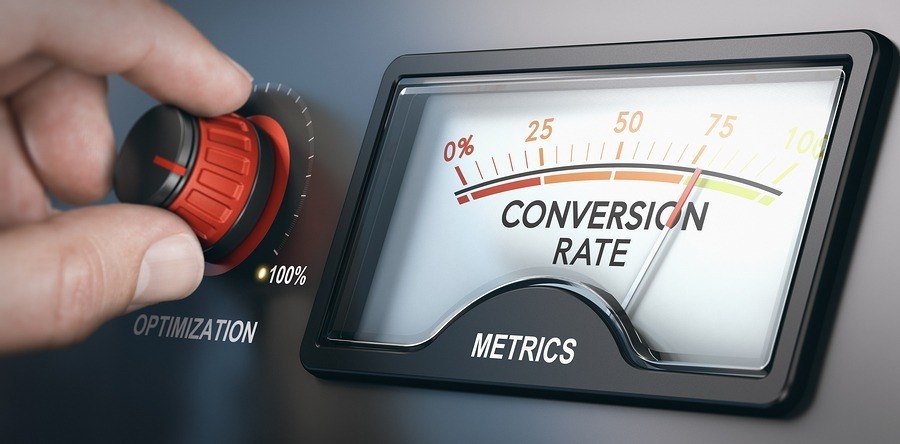
When it comes to headlines, the same formulas or strategies won’t work on every audience. You have to figure out what your specific readership responds to best.
Maybe a list post appeals to your audience. Deliver what they want to read.
But first, you have to examine the data. Along with the headline writing tips, monitor these crucial metrics to ensure the success of your headlines.
Click-Through Rates
Click-through rate measures the ratio of clicks on a specific link to the number of times it’s shown. It’s a top-notch metric for gauging headline effectiveness.
When your headline gets lots of clicks, you know you’re doing something right. But if not, it’s time to shake things up.
Measuring CTR works wonders regardless of the type of content you’re crafting.
Engagement Metrics
A good headline will be catchy and compelling enough to engage the reader.
Here are some more metrics to help gauge your headline’s performance:
- Page/Website Visits: Think of it as foot traffic to your digital storefront. Each visit reflects someone attracted by a blog, email, or social media post headline. It made them want to explore your content further.
- Scroll Depth: This has more to do with your overall content. Still, scroll depth indirectly reflects your headline’s ability to capture initial attention.
- Bounce Rate: The bounce rate shows how many visitors leave your website after only viewing the headline. A lower bounce rate is indicative of a well-written headline and captivating content.
Dwell Time
Dwell time clocks how long visitors linger on your website after clicking through from a headline.
It’s like a digital hourglass, measuring the allure of your content.
A longer dwell time signals content success. It indicates that visitors are captivated and exploring further. Conversely, a shorter dwell time may hint that your headline could have hit the mark better.
Social Media Sharing
Users commonly share content solely based on powerful headlines. This is often due to time constraints.
A compelling headline may be enough to assure them of the value it offers to others.
It could generate numerous likes and shares across social platforms. These include Facebook, Twitter, Instagram, YouTube, and others.
Likewise, in email, this could translate to metrics like the volume of email forwards.
Again, these metrics are primarily focused on gauging overall content performance. That said, they also double as reliable indicators of headline effectiveness.
Comments and Questions About What You are Promoting
Great headlines can also promote conversation. You might get comments on your blog posts or social media about the articles you’re writing, the products you sell, or the services you offer. Track these interactions to see if they correlate to certain headline types.
Headline Writing “Formulas”

I’m not a huge fan of the word “formula,” so I’m using it loosely. When I think of a formula, I imagine a process or recipe that must be followed to the letter.
Headline formulas are a little different You want to exert your creativity over the process.
SHINE Approach
SHINE is an acronym that boils down to these five words:
S – Specificity
H – Helpfulness
I – Immediacy
N – Newsworthiness
E – Entertainment value
You don’t have to pack all five of these qualities into every headline. However, if you can hit at least one or two notes, your headline will probably perform better.
Basic headline formula: Problem, solution, promise
This is one of the best techniques for writing headlines because it allows for plenty of creativity.
- Introduce a problem
- Suggest a solution
- Promise a result
Let’s build one from our marathon runner example article:
“Sick of Sore Feet? Try These 12 Tips to Banish Aching Feet for Good”
Can you pick out each element?
- Problem: “Sick of Sore Feet?”
- Solution: “Try These 12 Tips”
- Promise: “Banish Aching Feet for Good”
You can use this formula for just about any headline or topic.
“Little-known ways” formula
There’s one great way to immediate capture interest from your target audience. Introduce “little-known ways” to solve a problem or reach a goal.
The formula works because it suggests that the reader won’t have heard of the tips you’re going to suggest. Of course, you need to back up the headline with a slam-dunk article.
“Who else wants” headline formula
The Neil Patel homepage is the perfect example of the “who else wants” formula in action:
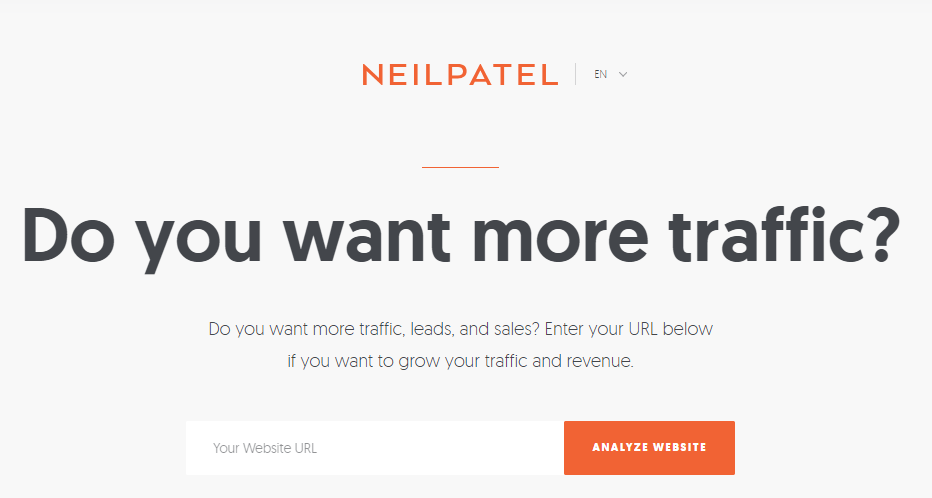
The headline asks, “Do you want more traffic?” It implies that Neil can deliver results for that goal if you follow through by entering your information.
You don’t have to use the exact verbiage “who else wants,” but you can:
- Who Else Wants Better Running Shoes?
- Who Else Wants to Run a Marathon?
- Who Else Wants to Beat Your Last Marathon Time?
This headline style is great for community building, too, because it encourages conversation.
“Get rid of” headline technique
We all have things we want to get rid of — telemarketing calls, inflated gas prices, bed bugs, whatever.
(To be clear, I don’t have bed bugs. There are no bed bugs in my home.)
The point here is that a “get rid of” headline promises a solution to the problem your audience faces. Think about what they might want to get rid of.
For my runner example, my audience might want to get rid of those stubborn last five pounds, calluses, shin splints, or leg cramps. If I can help them resolve the issue, I’ll have won a fan.
FAQs
Q 1. How do you write a perfect headline?
A. To craft a perfect headline, start by understanding your audience’s needs.
Additionally, implement headline writing tips like the use of power words words and phrases that keep readers engaged. Ensure clarity and relevance to the content. Experiment with different styles and formats and analyze their performance.
Finally, refine your headlines based on search traffic and data.
Q 2. What is the 80/20 rule of headlines?
A. The 80/20 rule highlights that only 20% of readers typically proceed past the headline. The remaining 80% may not engage further.
Therefore, crafting killer headlines is crucial. It determines whether the majority of your audience will delve into the rest of your content.
Q 3. What is the formula for writing a headline?
A. Headline formulas serve as templates for writing great headlines. They break down the structure of a headline into specific elements. This way, you have a roadmap to craft engaging headlines consistently.
Below are some popular headline formulas:
- How To: Offers practical guidance or solutions to a problem.
- Problem-Solution: Identifies a problem and offers a solution.
- “Who Else Wants”: Appeals to shared desires or aspirations.
Q 4. What is a direct headline?
A. A direct headline is concise and straightforward. It conveys the main benefit or message of the content without any fluff.
Such headlines aim to grab the reader’s attention quickly. They’re often used in advertisements and marketing materials.
Q 5. What is a headline structure?
The structure of a headline generally follows these key components:
- Subject: The main topic or the key entity involved.
- Verb: Action or state of being that pertains to the subject.
- Object: The recipient of the action or additional detail about the action.
- Modifiers: Additional information or context, often concise and impactful.
- Keywords: Essential terms that highlight the significance or timeliness of the topic.
Conclusion
The best headline writing tips and techniques help you connect with your audience. They evoke an emotional or automatic response to the subject matter.
However, you need a tactical approach.
Try each of these techniques for writing headlines, then come back and tell me which one(s) worked best for you. Don’t forget to carefully study your favorite headlines, apply the four U’s, get to know your audience, and offer personal benefits.
If one headline structure doesn’t work, try another. You can always re-engineer content that doesn’t meet your expectations.
Do you have a favorite headline formula? Share it with the class!



